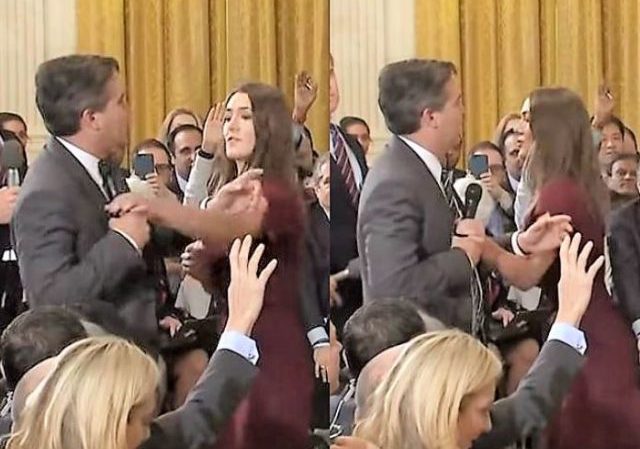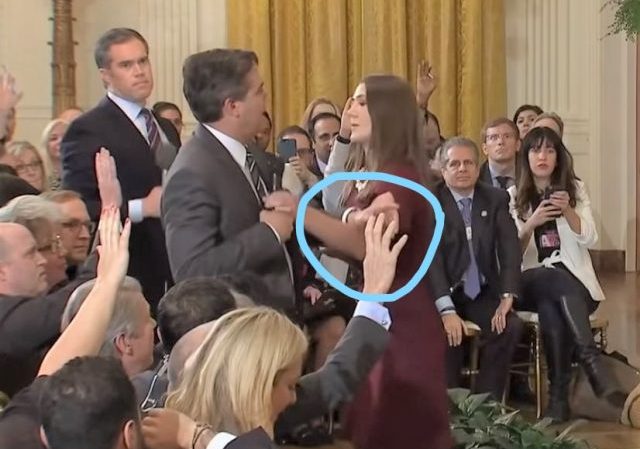Gov’t: Trump has discretion to limit Acosta access, particularly after “disrupting press proceedings”

On November 13, 2008, CNN and Jim Acosta filed in federal court in D.C. for a temporary restraining order and preliminary injunction seeking a court order overruling the White House decision to revoke Acosta’s “hard pass” — the press pass that provides Acosta with “regular and unescorted access to the White House and White House briefings.”
Acosta’s hard pass was revoked after a November 7, 2018, incident during a press conference when Acosta refused to yield the floor after having asked two questions, and physically blocked with his arm and hand a White House intern from taking back the microphone as the Trump wanted to call on someone else.
The media falsely has claimed that the video of the incident circulated by Sarah Sanders was “doctored,” when in fact a portion of it was slowed down to see more clearly the arm and hand contact. It was obvious that a portion was in slow motion, and nothing was doctored. Whether full speed or slow motion, it shows Acosta using his arm and hand to block the intern as he refused to yield the microphone.
As an example of media falsely claiming the video was doctored, WaPo has produced this side-by-side video, which has over 600,000 views. But all the video show is that the slow motion accurately demonstrates the contact, much as slow motion video in football can who if a ball hit the ground (thinking of the famous Edelman catch).
The Complaint and motion papers are included in our prior post, CNN sues Trump over suspension of Jim Acosta’s press pass after he got physical with White House intern. The relief CNN and Acosta seek is extraordinary — it would involve the Court in the micromanagement of White House press conferences and press access policies
The Court set a hearing on the TRO request for today at 3:30 p.m., and required that the government file its opposition by 11 a.m. this morning.
The government filed its Memorandum in Opposition to the TRO (pdf.)(full embed below).
Here is the introduction to the government’s memo of law:
On November 7, 2018, the White House revoked the “hard pass” of CNN Chief White House Correspondent Jim Acosta—the pass that permitted him broad, on-demand access to the White House grounds—following an incident in which he disrupted the fair and orderly administration of a press conference during an exchange with the President. That discretionary decision was lawful. The President and White House possess the same broad discretion to regulate access to the White House for journalists (and other members of the public) that they possess to select which journalists receive interviews, or which journalists they acknowledge at press conferences. Plaintiffs deny that this broad discretion exists, but under even their curtailed view of the White House’s authority, revoking Mr. Acosta’s pass was permissible. That revocation was premised on stated reasons that are viewpoint- and content-neutral and are evident from the video of the November 7 press conference. Because the White House’s decision comports with the First Amendment and the Due Process Clause, and because Plaintiffs have fallen short of the high showing necessary for the extraordinary remedy of emergency relief, the motion for a temporary restraining order should be denied.
In particular, the government pointed out the wide discretion the White House has in controlling press access to the president:
Foremost, Plaintiffs are unlikely to show a likelihood of success on the merits. With respect to their First Amendment claim, the President and his staff have absolute discretion over which journalists they grant interviews to, as well as over which journalists they acknowledge at press events. That broad discretion necessarily includes discretion over which journalists receive on-demand access to the White House grounds and special access during White House travel for the purpose of asking questions of the President or his staff. No journalist has a First Amendment right to enter the White House and the President need not survive First Amendment scrutiny whenever he exercises his discretion to deny an individual journalist one of the many hundreds of passes granting on-demand access to the White House complex. Plaintiffs rely on the D.C. Circuit’s decision in Sherrill v. Knight, 69 F.2d 124 (D.C. Cir. 1977), but that case is not as broad as they suggest.Far from establishing all-purpose rules for regulating White House press passes—rules that apply to everything from the Secret Service’s determinations about security risks to the President’s personal exercises of discretion based on his first-hand observations—Sherrill addressed solely the Secret Service’s decision to deny a pass on security grounds to a journalist to whom the White House had otherwise decided to grant access. That critical predicate is absent here; “all parties” do not “recognize” that Mr. Acosta deserves access to the White House as soon as he clears a Secret Service security review. Id. at 131 n.22. In stark contrast to Sherrill, Mr. Acosta’s access has been denied at a different stage in the decisional process (the White House’s discretionary decision about which journalists to speak with), ratified by a much higher-level decisionmaker (the President), and is based on a personal interaction between the President and Mr. Acosta (the November 7 press conference). But even if the rules Sherrill expounded apply equally here, those rules have been satisfied. Sherrill bars only denials “based on arbitrary or less than compelling reasons.” The stated rationale for the revocation of Mr. Acosta’s pass—that he was disrupting press proceedings—is evident from the video he has proffered, is entirely viewpoint- and content-neutral, and clears this limited bar.
The government disputed that Acosta had a First Amendment right to the press pass:
Plaintiffs’ First Amendment argument rests on the assertion that “there can be no question that the revocation of Acosta’s credentials is a content and viewpoint-based punishment imposed on him because the President and his administration do not like CNN or Acosta’s reporting.” Pls.’ Br. 11. Not so. Even in this preliminary posture, the record available to the Court contradicts Plaintiffs’ characterization. Rather, as the Press Secretary publicly explained, Mr. Acosta’s conduct impeded the White House’s ability to “run an orderly and fair press conference[.]” Sanders Statement; see also id. (“After Mr. Acosta asked the President two questions—each of which the President answered—he physically refused to surrender a White House microphone to an intern, so that other reporters might ask their questions. This was not the first time this reporter has inappropriately refused to yield to other reporters.”).First, Plaintiffs’ own description of the November 7 press conference validates the White House’s stated reasons for revoking Mr. Acosta’s hard pass. In Plaintiffs’ telling, Mr. Acosta asked a question of the President, but the President did not permit him a follow-up. Compl. ¶¶ 33-34. Rather than acknowledge the President’s attempt to move on to a different journalist, however, Mr. Acosta continued to try to hold the floor, such that a White House staffer attempted to physically reclaim the microphone Mr. Acosta had been using. Id. ¶ 34. Even after the staffer actually had her hands on the microphone, Mr. Acosta continued his refusal to permit another journalist to ask a question, ignoring both the stated wishes of the President and the efforts of a staffer tasked with helping to manage the event. See id.; see also Donaldson Decl. ¶ 9 (acknowledging the salience of “Jim Acosta’s conduct” during the press conference).
Perhaps the government’s best point is somewhat buried — if the White House was motivated by hostility to CNN and Acosta’s political viewpoint, why was there not prior retaliation until this incident?
Second, Plaintiffs claim that the decision to revoke Mr. Acosta’s hard pass was the result of the President’s allegedly “clear . . . antipathy” for “CNN [and] Acosta’s reporting.” Pls.’ Br. 11. But approximately 50 other CNN journalists retain hard passes to enter the White House complex, undercutting their argument that revoking Mr. Acosta’s pass was part of an effort to punish or silence CNN. Plaintiffs’ complaint alleges that this antipathy is longstanding, without any plausible explanation as to why there were no allegedly retaliatory actions against Mr. Acosta previously. Compl. ¶¶ 27-29. The more natural explanation for the White House revoking Mr. Acosta’s pass on November 7, 2018—and to not revoke any of the other 50 passes held by CNN journalists—is that Mr. Acosta’s revocation is based on his conduct at the November 7, 2018 press event.
The government SHOULD win this TRO motion.
The key factor is that Acosta demonstrably was disruptive, refused to yield the floor, and blocked the intern.
If the Court imposes on the White House as to Acosta, where does the line get drawn? What level of disruption and obstruction will be permitted of media in the room? Will the court force Trump to call on Acosta?
A Court should be very hesitant to get involved in this on an emergency basis in light of the clear video showing, at minimum, disruption by Acosta after being asked repeatedly to stop.
——————————–
CNN and Acosta v. Trump – Gov’t Memo in Opposition to Motion for TRO by Legal Insurrection on Scribd
CLICK HERE FOR FULL VERSION OF THIS STORY
